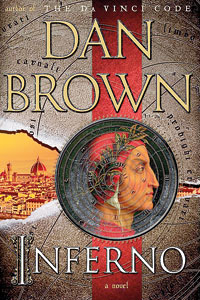Inferno: A formulaic Dan Brown thriller, but still enriching
Having finished reading Dan Brown’s latest bestseller Inferno, I have to say I am getting a little weary of his books. I rushed to the bookstore to get a copy of the much hyped book, my heart skipping a few beats when I saw it displayed grandly on the shelf. I ran my fingers over its sleek and shiny cover taking in each detail, I smelt the fresh pages of the book in the same way a lover would seek out the familiar smell of her beloved. I read the front and back covers savouring each word and then came across the thought provoking words of Dante Alighieri – “The darkest places in hell are preserved for those who maintain their neutrality in time of moral crisis”.

And I was ready to dive into the length, breadth and width of what the master storyteller had cooked up in his latest book. My fingers carefully turned the page to the First Chapter and I lost all sense of the mundane matters going on around me.
I was soon teleported to the glorious Italian city of Florence where a man mysteriously jumps to his death from a tower and next, the protagonist of the book Robert Langdon (yes, the same eminent Harvard Professor we encountered first in Angels and Demons, next in The Da Vince Code and again in The Lost Symbol)) is lying semiconscious having suffered a gunshot wound to his head. And from there onwards it’s a typical Dan Brown roller coaster ride kind of thriller that takes you through narrows alleys, ancient tunnels, secret hideouts, hidden ceilings, museums and the congested roads of Florence and towards the latter parts of the book, to the city built on water- Venice.
Brown’s book is based on Langdon’s race to stop a mad scientist from succeeding in his plans to bring about a drastic drop in the world’s population. The antagonist is dead but leaves clues that are contained in Inferno, the first part of the epic poem by Italian poet Dante – The Divine Comedy. Langdon uses clues contained in Dante’s poem as well as from Florentine painter Sandro Botticelli’s (1445-1510) Map of Hell that was inspired by the poem to help in his frantic chase to stop the mad scientist from succeeding in his evil plan.
Till halfway through the book I enjoyed the ride along with Langdon and his sidekick Sienna Brooks, a troubled child prodigy who grows up to become a medical doctor but carries a lot of emotional baggage around with her. She is sharp and smart and saves Langdon several times from near death. The two are in good company. The other main characters include the brilliant but mad scientist who is about to find a unique solution to the problem of overpopulation by reducing the present world population of seven billion to four billion, the Director General of the World Health Organisation (WHO) who is out to stop him, the head of a shadowy consortium who is hell bent on keeping his word to his client (the mad scientist) even if it means untold destruction to the human race and a few others who join in to make the ride a tolerable one most of the way.
When all the question marks that Brown characteristically leaves at the end of each of the chapters begin to unravel towards the end, predictability sets in and the story becomes almost as predictable as that of a Bollywood movie. Maybe Dan Brown’s magic formula is becoming a little stale for me. Predictability to that extent dampened the enthusiasm with which I picked up the book.
But Inferno is not without its plus points and if I were an Italian, I would canvass hard to get an honorary citizenship of that country for Dan Brown. After all, in the same way that The Da Vinci Code made millions rush to Italy and take a closer look at Leonardo da Vinci’s masterpiece “The Last Supper,” there will be thousands scrambling to Florence, Dante’s hometown to see the sites of that magnificent city that Brown has so vividly described in this book.
Dante wrote his epic poem after he was exiled from Florence around 1300. The journey begins on Good Friday in 1300 with Dante finding himself in a dark forest after being exiled .Here he meets the ghost of his favourite author, the Latin poet Virgil who tells him he can only escape Hell after taking the journey through it to Purgatory and Paradise. With Virgil as his guide, Dante descends down the nine funnel shaped tiers of Hell, passing heretics, seducers, perjurers and traitors and finally encountering Judas , the betrayer of Christ and Brutus, the betrayer of Julius Caesar, both of who are the most tormented by Satan at the centre of Hell.
The Divine Comedy is divided into three equal sections starting with Inferno which concerns Dante’s descent into Hell, the second part known as Purgatorio ( Purgatory) describes his ascent out of Purgatory and Paradiso (Paradise ) which describes Dante’ s journey through heaven till he reaches the Empyrean of God.
Dan Brown confines his book to the decent into Hell, filling in some fascinating details along the way and awakening us to the brilliance of an Italian poet who lived many centuries before us. Though I was left disappointed by the way the story reached its climax and found the over- descriptive nature of his writing tedious at times, it must be said in fairness to the author that one can’t really lose out by reading one of his books because the sheer volume of research material Brown incorporates into his works can only leave the reader richer in knowledge.
Follow @timesonlinelk
comments powered by Disqus


